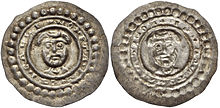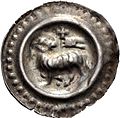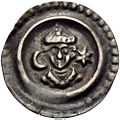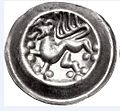Eternal penny

The so-called Ewige Pfennig , Latin Denarius perpetuus , is a pfennig coin of the regional pfennig period ( bracteate period ), which was struck until the late medieval penny period . The coin is largely a Hohlpfennig who had unlike Brakteaten that are exchanged regularly to charges, not the annual Münzverrufung subject.
Coin history
Disrepute, Renewal, and Exchange
After a year, the bracteaten pfennigs had to be exchanged for a fee, twelve old ones for nine or ten new ones. The old ones were declared invalid and replaced by coins with new coin designs. The excess should cover the minting costs and generate a profit. The Freiberg city law provides an example of how the exchange should be enforced :
“Swenne the Munzmeister throw nuwe pennies, so sullen si di alden forbid lazen. They will still have ane vare for some other days. Then you must break where you find yourself in the market. "
[If the mint masters throw out new pennies, they should have the old ones forbidden. They may then (stay?) For a fortnight. Then let them break them wherever they find them in the market.]
The penny was only valid where it was struck. Trading in the market was only allowed with local coins, the place of manufacture of which is mostly identical to the market place. Anyone who came from another currency area to trade had to exchange the coins they brought with them for common ones at a loss. For example, the exchange fee for exchanging Freiberg pfennigs in the Meissnian currency area corresponded to a wealth tax of 25%. The exchange fee was part of the income of the mint master. In the Görlitzer Stadtbuch from 1305 it was read that the margravial Brandenburg mint master Heinrich von Salza had promised not to break the coins on the weekly markets (to make them unusable for trading) in exchange for an interest-free loan of 100 silver marks . However, he had to be judged to comply with the agreement. Eventually the city of Görlitz bought the right to mint coins from the sovereign.
See also: Saxon coin history # Bracteatenzeit
Introduction of the so-called Eternal Penny
In order to create stable conditions for trade and industry, the trading towns were mainly interested in taking coinage into their own hands in order to mint the "Eternal Pfennig" and thus the annual coin call and the territorially restricted validity of the bracteate pennies combined with compulsory exchange and To eliminate the obligation to pay fees, as well as to abolish the constant deterioration of coins.
The frequent lack of money of the minters gave many cities the opportunity to lease the mints of the sovereigns and buy them later. Examples are:
- 1179: Cologne receives the coin as pledge for 1000 marks of silver as a loan for Archbishop Philipp .
- 1272: Stade buys the right to mint.
- 1291 or 1354: Erfurt , own coinage
- 1293: Hamburg leases the mint from the Count of Holstein , 1325 Hamburg has the right to mint.
- 1293: Lüneburg receives the right to mint.
- 1295: Constance buys the right to mint.
- 1296: Braunschweig receives the mint as a pledge, 1412 as property.
- 1296: Strasbourg , own coinage
- 1325: Stralsund and Rostock receive the right to mint.
- 1332: Hanover receives the coin as property together with the knighthood .
- 1369: In the margraviate of Brandenburg , several cities, including Berlin , Brandenburg and Stendal , paid the margrave a one-time settlement and were given the right to mint the “Eternal Penny”.
- 1373: Basel , own coinage. The newly elected Bishop Johann von Vienne pledged the right to coin the city for the amount of 4,000 guilders. Hollow pennies were issued with the Basel staff as a coin image.
After the mints were taken over, new coins were usually minted. However, since no comprehensive regulations were implemented between the cities and states, the coin deterioration could not be eliminated.
So-called perpetual pennies of the hollow pfennig type, diameter 19 to 21 mm, weight 0.32 to 0.54 g are shown in the following pictures:
Switzerland, St. Gallen (Abbey) , minted from around 1273
Constance (diocese) , Bishop Heinrich II. Von Klingenberg (1293–1306)
Lindau , royal mint, minted from 1295 to 1335
Berlin Mint
The opportunity to introduce the Eternal Penny was
"[...] when the countryside and cities of the Mittelmark bought the coin from Elector Otto in 1369 for 6500 Marks of silver: so this city, belonging to the Berlin Mint Minister, was also among those who were still entitled to strike pennies and scherfen , and received a letter of protection from the elector. With this coin justice the so-called perpetual penny was introduced […]. Before 1369 it had been in use in coinage that, in order to prevent the coin from deteriorating and yet to maintain the costs and a considerable surplus, the coins were renewed annually and the pennies struck were only valid for one year. After this one had to change them from the mint master for newly minted ones and generally lose the fourth part. […] And now in 1369 the annual renewal stopped entirely. A Spandow pfennig […] was a hollow coin on which a balaclava with a piston was struck, which made up part of the city 's coat of arms . "
In 1369, Margrave Otto VIII (1365–1373) left the minting of the so-called Eternal Pfennig to the estates in the Stendal and Berlin minting districts in return for a one-off compensation . However, after just a few years, the "forever" guaranteed coinage was abolished. Emperor Karl IV bought the Mark Brandenburg from the Wittelsbach margrave in 1373 and reorganized the coinage. The hollow coin with balaclava as a coin image mentioned by Fischbach does not correspond to the denarius with the Berlin bear minted on both sides , which instead of this hollow coin is known as the so-called Eternal Pfennig. In more recent literature, however, it is not ruled out that the helmet pfennig can be the Berlin “Ewige Pfennig”.
Web links
Individual evidence
- ↑ Wolfgang Steguweit : History of the Gotha Mint from the 12th to the 19th Century. Weimar 1987, p. 17.
- ↑ Karl Walker: The money in history. Rudolf Zitzmann Verlag, Lauf near Nuremberg, 1959
- ^ Walther Haupt: Sächsische Münzkunde . German Verl. D. Wiss., Berlin 1974, Berlin 1974, p. 29.
- ↑ a b Friedrich von Schrötter, N. Bauer, K. Regling, A. Suhle, R. Vasmer , J. Wilcke: Dictionary der Münzkunde , Berlin 1970 (reprint of the original edition from 1930), p. 440.
- ^ Walther Haupt: Sächsische Münzkunde . German Verl. D. Wiss., Berlin 1974, Berlin 1974, p. 32.
- ^ Walther Haupt: Sächsische Münzkunde . German Verl. D. Wiss., Berlin 1974, Berlin 1974, pp. 32/34.
- ↑ Heinz Fengler, Gerd Gierow, Willy Unger: transpress Lexikon Numismatik , Berlin 1976, on the basic statement.
- ↑ Arthur Suhle: The coin. From the beginnings to modern European times , Leipzig 1969, p. 127 (also mentioned Erfurt and Strasbourg).
- ^ Acsearch: Ewige Pfennige - Passau; Switzerland, St. Gallen; Constancy; Lindau; Überlingen; Braunschweig (city); Salzwedel. The Passau pfennigs, d = 18 mm, 0.55 to 0.66 g, are embossed on both sides, all others are hollow pfennigs, d = 20 to 22 mm; 0.37 to 0.53 g.
- ↑ Heinz Fengler, Gerd Gierow, Willy Unger: transpress Lexikon Numismatik , Berlin 1976, p. 87.
- ↑ Bernhard Harms: The coin and monetary policy of the city of Basel in the Middle Ages , pp. 24 and 26.
- ↑ Friedrich L. Fischbach: Historical political, geographical and military contributions concerning the Royal Prussian and neighboring states . Volume Two of the Third Part. Berlin, 1785. Therein: Diplomatic history of the city and fortress Spandau, Münzerechtigkeit, p. 405.
- ↑ Interactive catalog - Münzkabinett der Staatliche Museen Berlin, under map / Europe / Germany / Mint - Berlin, tray 14/147: Münze 252/2634, commentary Brandenburg, Mint District Berlin, Denarius 1369-1374 (?), Standing margrave with lance in the right and lowered sword in the left / back side: Bear running to the left, weight 0.59 g, diameter 15 mm, Berlin Mint (Bahrfeld 626, Dannenberg 261, Kluge 544).
- ↑ Interactive catalog - Münzkabinett der Staatliche Museen Berlin, under Map / Europe / Germany / Mint - Berlin, tray 14/147: Münze 251/2634 Brandenburg, Margraviate, Friedrich II. (1440–1470) Margrave and Elector of Brandenburg, Hohlpfennig 1463 –1468 (?), Helmet with crest to the left, weight 0.28 g, diameter 16 mm, Berlin Mint (Bahrfeld 16, Tewes 58, Kluge 547).
- ↑ Interactive catalog - Münzkabinett der Staatliche Museen Berlin, under Map / Europe / Germany / Mint - Berlin, tray 14/147: Münze 252/2634 .
- ^ Wittelsbacher and Luxembourg Margraves in Brandenburg - City of Berlin: Denarius (Ewiger Pfennig).



